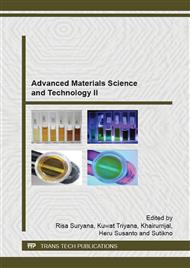p.364
p.368
p.373
p.378
p.383
p.387
p.391
p.397
p.402
Identification of Carbon Dots in Waste Cooking Oil
Abstract:
We found carbon dots (C-Dots) in waste cooking oil. The C-Dots were formed as result of heating process. The Heating process caused carbon chains on waste oil were cut off and suffered rearrangements (polymerization) of carbon chains that accompanied with the process of carbonization. Luminescence C-Dots were observed while C-Dots on waste oil was irradiated by UV Light and the emissions were radiated in the visible light area which looks yellow-greenish color. The Heating process with different temperatures caused changes in the structure and the band gap energy. Structural changes were observed from the FTIR spectrum where the intensity of functional groups C ⎯ OH, C ⎯ H and C = O on a degraded waste oil. While the band gap energy of C-Dots displaces due to hydrothermal processes with different heating temperature. The Band gap energy shifted from 0.5 eV to 2 eV at 300οC of heating temperature. This study shows that we found an alternative raw material for luminescence materials.
Info:
Periodical:
Pages:
402-405
Citation:
Online since:
August 2015
Keywords:
Price:
Сopyright:
© 2015 Trans Tech Publications Ltd. All Rights Reserved
Share:
Citation:


